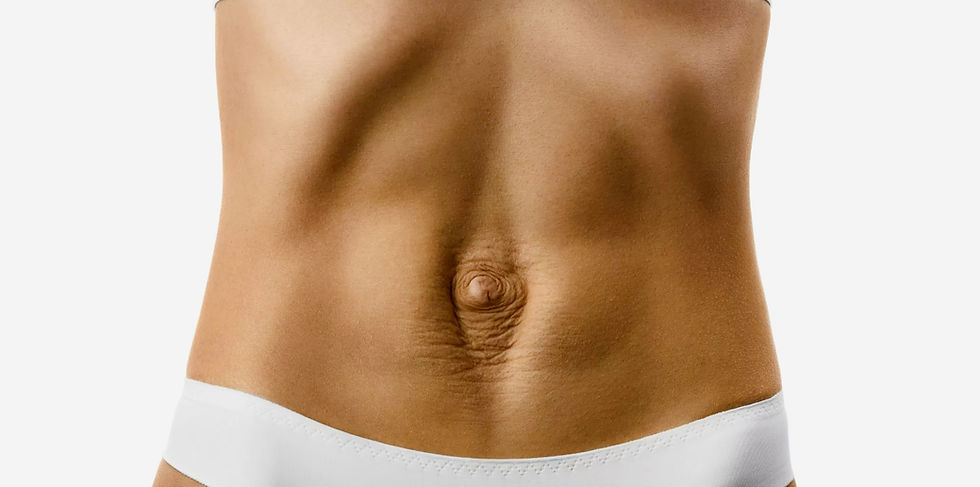What is Diastasis Recti? Why Does My Belly Feel ‘Empty’ or Soft?
- Priscilla Lim

- Dec 28, 2024
- 3 min read
A ProVital Physiotherapy Guide
Have you ever looked at your tummy and wondered why it feels soft, empty, or bulging especially after pregnancy, heavy lifting, or weight changes? You may be experiencing a condition called Diastasis Recti, also known in simple terms as the “empty belly” problem.
At ProVital Physiotherapy Centre, we see many clients especially women after childbirth or individuals who lift weights who are surprised to learn that their unusual belly shape or weakness isn’t fat, but a separation of their abdominal muscles.
1. What is Diastasis Recti?
Diastasis Recti is the separation of the rectus abdominis muscles—the “six-pack” muscles in the front of your abdomen. Instead of sitting close together, the muscles are pulled apart, leaving a gap down the centre line (called the linea alba).

This condition may cause:
✔ A bulge or “doming” shape when sitting up or coughing
✔ A soft or “empty” feeling when touching the belly
✔ Weakness in the core muscles
✔ Lower back pain
✔ Poor posture or pelvic discomfort
2. Who Gets Diastasis Recti?
✔ Women after pregnancy (postpartum mothers) — due to the abdominal wall stretching during baby growth
✔ Men or women who do excessive heavy lifting without proper core engagement
✔ People with obesity or rapid weight gain
✔ Newborn babies (temporary and usually resolves on its own)
At ProVital Physiotherapy Centre, most of our Diastasis Recti clients are postnatal mothers seeking help for tummy weakness and core function, not cosmetic reasons, but for better strength, posture, and comfort.
3. How Do I Know If I Have Diastasis Recti?
Try this simple self-check at home:
Lie on your back, knees bent.
2. Lift your head slightly off the floor.
3. Use your fingers to press into your midline, just above or below the belly button.
4. If you feel a gap wider than two finger widths, or a “soft hole” feeling, you may have
Diastasis Recti.
However, for accurate diagnosis and safe rehabilitation, consult a trained physiotherapist at ProVital.
4. Why Is Diastasis Recti Important to Address?
If left untreated, Diastasis Recti can lead to:
❌ Poor core strength
❌ Chronic lower back pain
❌ Pelvic floor dysfunction (leakage, heaviness)
❌ Postural changes
❌ Increased risk of hernia
At ProVital Physiotherapy Centre, we don’t just care about appearance, we focus on restoring function, strength, and confidence in daily movement.
5. Can Exercise Help? YES! with Professional Guidance.
But NOT all exercises are safe for Diastasis Recti.
Unsafe (to avoid unless guided):
❌ Sit-ups
❌ Crunches
❌ Heavy front-loaded planks
Safe and recommended (under supervision):
✔ Core breathing techniques
✔ Transverse abdominis activation
✔ Pelvic floor muscle training
✔ Modified core strengthening
At ProVital, our physiotherapists guide clients through personalised, safe exercises to gradually close the gap and restore core stability.
6. When to Seek Physiotherapy for Diastasis Recti?
Book an assessment at ProVital Physiotherapy Centre Taman Desa KL if you experience:
✔ Visible tummy bulge or doming when coughing or sitting up
✔ Feeling of weakness or “emptiness” in the belly
✔ Post-pregnancy abdominal discomfort or core weakness
✔ Lower back or pelvic pain
We provide gentle, tailored rehabilitation to strengthen your core muscles safely and progressively.
7. Important Note: Nutrition and Weight Management Matter Too
While physiotherapy focuses on movement and strength, maintaining a healthy weight and supporting tissue repair with good nutrition can also help recovery. For dietary advice, we recommend speaking with a certified nutritionist or dietitian.
Conclusion: You Don’t Have to Live With a Weak or ‘Empty’ Belly
Diastasis Recti is common but manageable. With proper physiotherapy, guided exercise, and lifestyle care, you can rebuild a strong, stable, and confident core.
Contact ProVital Physiotherapy Centre Malaysia today for a personalised Diastasis Recti rehabilitation program. Let us help you feel strong from the inside out.
References:
1.Benjamin, D. R., van de Water, A. T., & Peiris, C. L. (2014). Effects of exercise on diastasis recti abdominis in the antenatal and postnatal periods: A systematic review. Physiotherapy, 100(1), 1-8. https://doi.org/10.1016/j.physio.2013.08.005
2.Spitznagle, T. M., Leong, F. C., & Van Dillen, L. R. (2007). Prevalence of diastasis recti abdominis in a urogynecological patient population. International Urogynecology Journal, 18(3), 321-328. https://doi.org/10.1007/s00192-006-0114-8
3.Hills, N. F., Graham, R. B., & McLean, L. (2018). Comparison of trunk muscle function between women with and without diastasis recti abdominis at 1 year postpartum. Physical Therapy, 98(10), 891-901. https://doi.org/10.1093/ptj/pzy084


